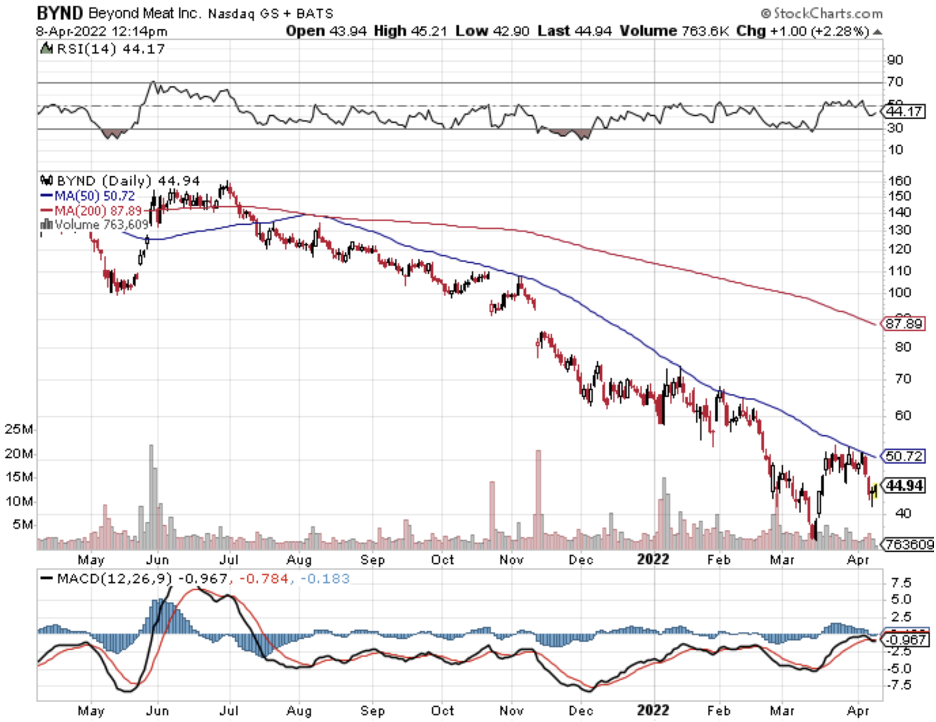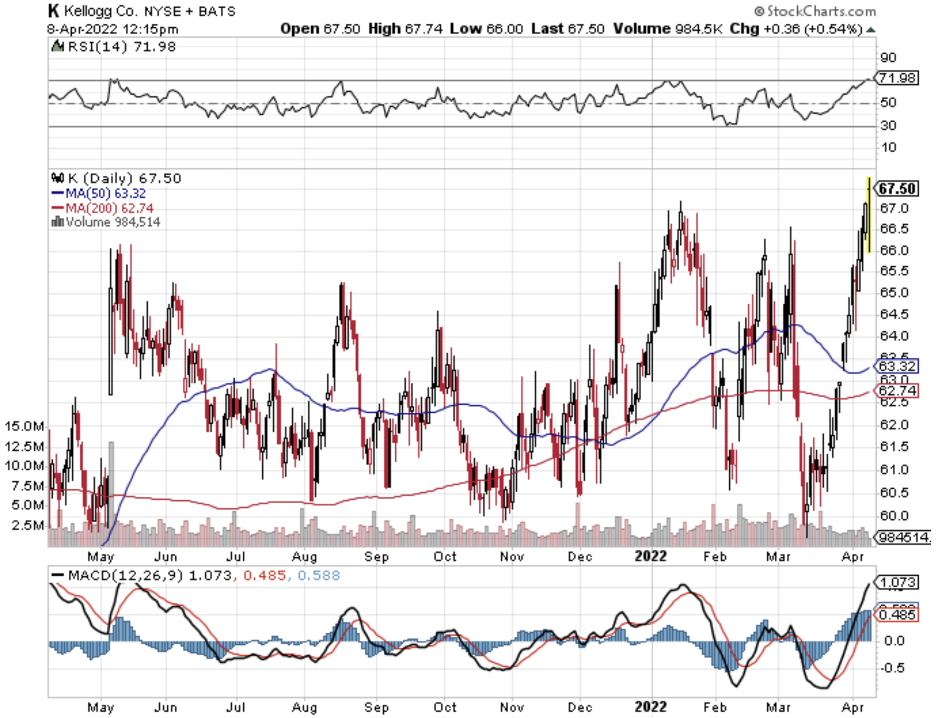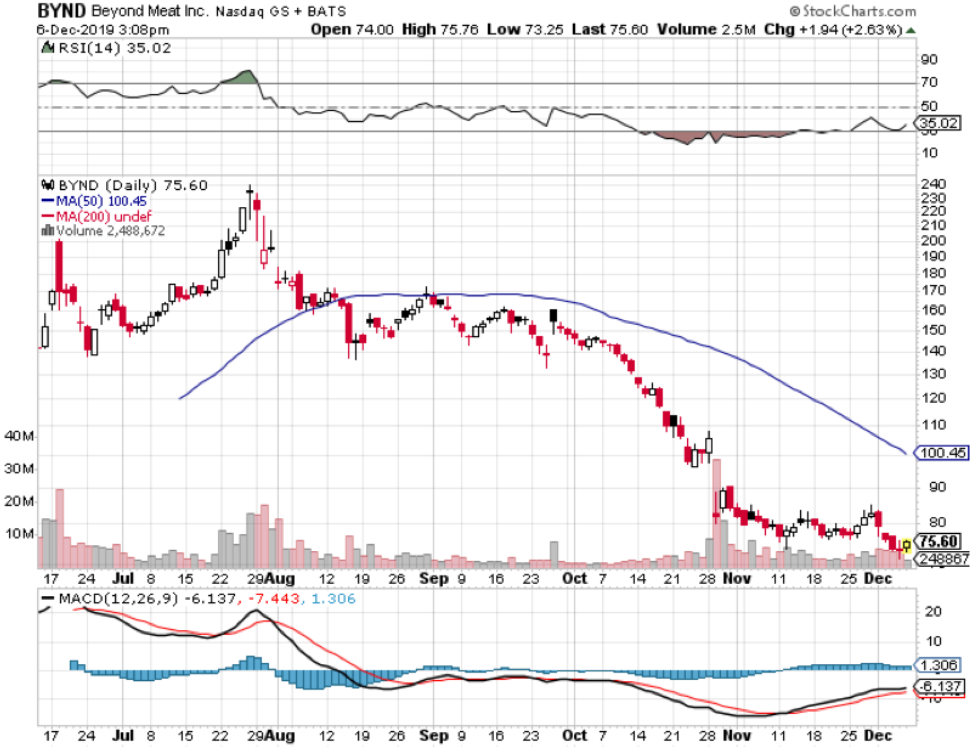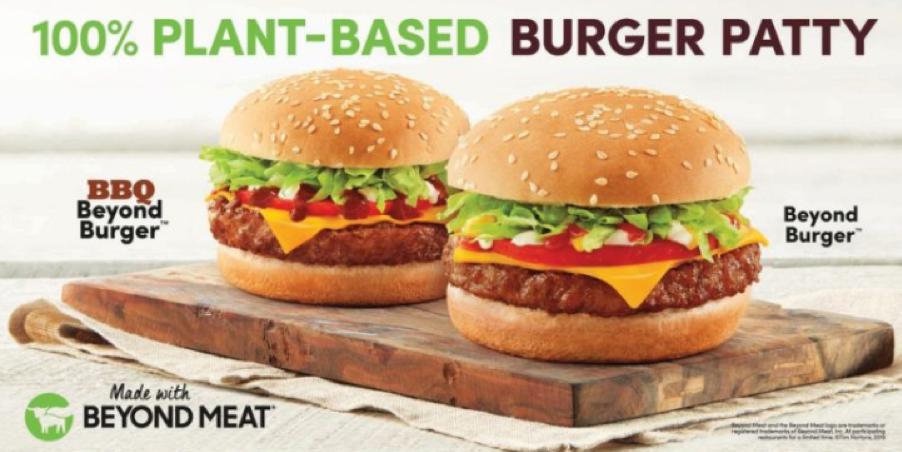Mad Hedge Technology Letter
April 8, 2022
Fiat Lux
Featured Trade:
(BEYOND MEAT CAN’T CATCH A BID)
(BYND), (K)

Mad Hedge Technology Letter
April 8, 2022
Fiat Lux
Featured Trade:
(BEYOND MEAT CAN’T CATCH A BID)
(BYND), (K)

Food tech was on a run when quantitative easing was generous, and many thought those times would never end.
QE even had the added bonus of propping up zombie companies that were hopeless at turning a profit and in tech, there are many that fit that bill.
With a crashing thud, food tech is going through a cringe-worthy reckoning as a drip of data points suggest that food tech’s growth phase could be in the rear-view mirror.
It’s pretty much inexcusable that something like this happens so early in the growth cycle.
This must be a kick in the teeth for the company Beyond Meat (BYND) which produces the plant-based burger called Beyond Burger.
Total revenue in 2021 of $465 million and a loss of $182 million is hard to swallow.
Exposed at the worst possible time while capital markets close off the spigots means that management will need to turn around this company without the tailwind of low rates.
This could go from bad to worse for BYND and that is why the stock has felt the full force of the pessimism with the stock pulling back from $200 in 2019 to $43 today.
There simply is a reduced appetite for growth tech and food growth tech is on the outer edge of what would be considered reasonable in terms of the risk paradigm.
Investors have deserted this stock in unison, and I expect a cold winter for BYND’s stock as investment research firm Piper Sandler just released its latest teen survey, and it contained a barrage of highly negative news for BYND.
Not only are teens losing interest in plant-based meat alternatives, they also don’t have much of a preference for branded plant-based meat.
Piper analyzed the results of the firm’s survey work with more than 7,000 teens and found that 43% either eat plant-based meat or are willing to, down from 47% last fall and 49% in the spring of 2021.
Of the teens who don’t eat faux meats, 34% said they were willing to try it, down from 38% in the fall, when Piper Sandler last polled consumers.
This huge reversal means that people actually do like eating real animal-based meat instead of the fake stuff ,or the technology morphing plants into fake meat is not good enough.
I believe it’s a mixture of the two.
People want that cow-based steak or burger and there simply isn’t a substitute for it.
The incremental case for eating a Beyond burger is now null and void, consumers might as well microwave some frozen chicken nuggets.
There is no advantage for the Beyond burger and it appears as if BYNDs management got a little too arrogant with their product that isn’t up to snuff.
Limitations are hard to stomach but I should say the truth: plant-based burgers just aren’t that good, period.
Beyond Meat is still the No. 2 preferred brand, just behind privately held Impossible Foods, and ahead of Kellogg’s (K) Morningstar Farms.
While Beyond Meat’s scale is a positive, given it has the resources to develop new products and partner with high-profile partners, a lack of loyalty means it may not be enjoying much of a first-mover advantage.
Often, it can be hard to turn around such negative sentiment.
I would advise investors to not believe in this reversal at this point in the economic cycle.
The Fed is more hawkish by the day and that doesn’t scream to me that investing my money into food tech is a great idea.
The cold winter for food tech is here and better to wait it out and watch from the sidelines.


Mad Hedge Technology Letter
December 9, 2019
Fiat Lux
Featured Trade:
(THE BEYOND MEAT BOMB),
(BYND), (TSN), (KRL), (K), (CAG)

Food tech stock Beyond Meat, Inc. (BYND) went from euphoric to absolute dud when shares surged above $240 at the end of July only to crash.
In general, tech stocks have had a successful year, but the second half of the year has been inordinately unkind to growth stocks and Beyond Meat bore the full brunt of the change in market sentiment.
Let me remind you that I am not saying this is a bad company or a bad stock like Uber (UBER) or Lyft (LYFT).
Hardly so.
Investors can take away many positives from their overarching story and even more so as the stock has come down from the heavens settling in the mid-70’s range.
First, plant-based food is not going away anytime soon and is intertwined with the Millennial ethos of living healthier and protecting the planet.
Nonprofit organization The Good Foods Institute has forecasted that the plant-based food market is valued at more than $4.5 billion in the U.S. and grew 11% year over year.
Plant-based meat rose 10% last year, a substantial decrease of 25% year over year, but industry experts believe there is a significant pipeline of international revenue just waiting there for the taking.
More than one-third have tried at least one plant-based meat product, a low figure, but of those that have tasted, 57% make a repeat purchase.
Internationally, sales are expected to go from a $12.1 billion market in 2019 to a $27.9 billion market by 2025. In 2018, plant-based meat sales comprised 1% of all dollar sales in total retail meat in the U.S. and that number is only going to rise.
Let’s compare it with another successful plant-based product that has matured into a winner – milk.
This market has developed into a $1.86 billion market and plant-based milk is further ahead than the plant-based dairy and meat market.
Fortunately, these juxtaposed markets represent substantially overlap and positive demographic correlation of plant-based milk and meat consumers could mean that plant-based meat companies could achieve a similar rise like the plant-based milk companies experienced.
Domestically, plant-based milk now has a 13% share of the overall retail milk market, exploding by 61% from the years 2012 to 2017 and a further 6% rise in 2018.
If plant-based meat enters into the same trajectory as their cousins’ plant-based milk, grabbing 10% of market share from the overall retail meat market is feasible.
The special sauce that initially propelled the share price to the Himalayan highs of July was the insane growth rate which last quarter came in at 211.5% year-over-year.
The company is also surprisingly profitable eking out a $4.10 million performance last quarter on almost $92 million of quarterly revenue.
But I would like to bring investors back to reality and remind them that the company only does $92 million of revenue per quarter and the one before that a touch above $67 million.
This company is still in its infancy and just because it bursts with life in its formative stages does not mean investors can extrapolate that for years ahead.
What are the headwinds and how far off are they?
The most unstable variable rearing its ugly head is intense competition imminently barreling towards Beyond Meat.
An outsized dosage of competition would take an axe to profit margins with minimal chance of a quick reversal even if Beyond Meat manages to offer an outperforming product.
Beyond Meat is the disruptor and reaped a dividend from the first-mover advantage and the subsequent network effects.
But that doesn’t mean larger companies can’t copy them and that is exactly what is happening as we speak.
The competition is rapidly intensifying, specifically from big box protein processors and packaged food players who plan to undercut Beyond Meat price points using excess capacity and a lower gross margin rate profile.
The companies coming for Beyond’s bacon are Tyson Foods Inc. (TSN), Kellogg Co. (K), Hormel Foods Corp. (HRL), and Conagra Brands Inc. (CAG).
These big players will dump volume onto the plant-based food market and Kroger Co. just announced it would introduce 58 plant-based items under its private label Simple Truth in 2020.
Beyond Meat’s strategic position could suffer if consumers prove less brand loyalty and more price-conscious, then Beyond Meat’s first-mover advantage could dissipate and dynamics could revert closer to commodity industry profit margins.
Investors are laser-like focused if Beyond Meat can maintain gross margins over 35% by layering strategic partnerships with businesses that have a widespread addressable audience base.
If Beyond Meat fails in this respect, the competition will gradually destroy its competitive advantage and tank its share price.
The quality of the product has a large role to play in this too.
Another possible headwind is that Impossible Foods’ Impossible Burger is favored by many taste experts in taste tests diminishing Beyond’s product to the second tier.
But If the company can mimic the taste of a high-quality burger and replicate at least 80% of that experience, the products are likely to stick leading to more investment to capture that last 20% of the taste experience.
It is yet to be determined if Beyond Meat can muscle itself through the gauntlet of rigmaroles, and technically, its overhyped beginnings have given way to a more modest share price as of late.
If the stock enters into the $50 price range, it would be an advantageous price point to scale into this leader of food tech, but I would monitor it closely because the narrative could change on a dime and the story could sour if their strategy begins to fail.


Legal Disclaimer
There is a very high degree of risk involved in trading. Past results are not indicative of future returns. MadHedgeFundTrader.com and all individuals affiliated with this site assume no responsibilities for your trading and investment results. The indicators, strategies, columns, articles and all other features are for educational purposes only and should not be construed as investment advice. Information for futures trading observations are obtained from sources believed to be reliable, but we do not warrant its completeness or accuracy, or warrant any results from the use of the information. Your use of the trading observations is entirely at your own risk and it is your sole responsibility to evaluate the accuracy, completeness and usefulness of the information. You must assess the risk of any trade with your broker and make your own independent decisions regarding any securities mentioned herein. Affiliates of MadHedgeFundTrader.com may have a position or effect transactions in the securities described herein (or options thereon) and/or otherwise employ trading strategies that may be consistent or inconsistent with the provided strategies.
This site uses cookies. By continuing to browse the site, you are agreeing to our use of cookies.
OKLearn moreWe may request cookies to be set on your device. We use cookies to let us know when you visit our websites, how you interact with us, to enrich your user experience, and to customize your relationship with our website.
Click on the different category headings to find out more. You can also change some of your preferences. Note that blocking some types of cookies may impact your experience on our websites and the services we are able to offer.
These cookies are strictly necessary to provide you with services available through our website and to use some of its features.
Because these cookies are strictly necessary to deliver the website, refuseing them will have impact how our site functions. You always can block or delete cookies by changing your browser settings and force blocking all cookies on this website. But this will always prompt you to accept/refuse cookies when revisiting our site.
We fully respect if you want to refuse cookies but to avoid asking you again and again kindly allow us to store a cookie for that. You are free to opt out any time or opt in for other cookies to get a better experience. If you refuse cookies we will remove all set cookies in our domain.
We provide you with a list of stored cookies on your computer in our domain so you can check what we stored. Due to security reasons we are not able to show or modify cookies from other domains. You can check these in your browser security settings.
These cookies collect information that is used either in aggregate form to help us understand how our website is being used or how effective our marketing campaigns are, or to help us customize our website and application for you in order to enhance your experience.
If you do not want that we track your visist to our site you can disable tracking in your browser here:
We also use different external services like Google Webfonts, Google Maps, and external Video providers. Since these providers may collect personal data like your IP address we allow you to block them here. Please be aware that this might heavily reduce the functionality and appearance of our site. Changes will take effect once you reload the page.
Google Webfont Settings:
Google Map Settings:
Vimeo and Youtube video embeds:
